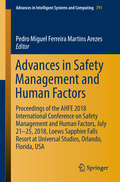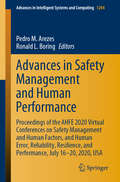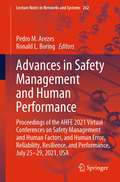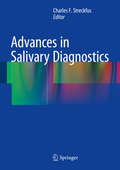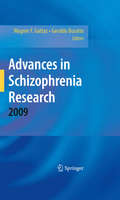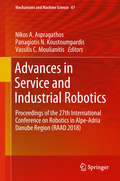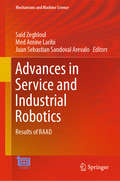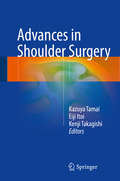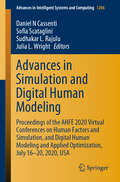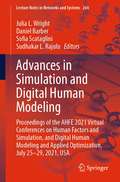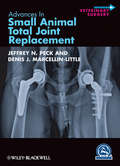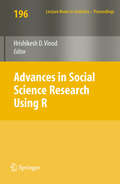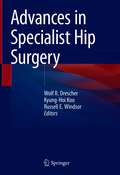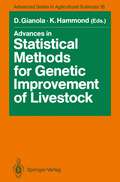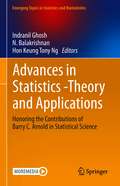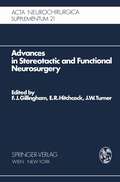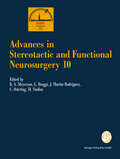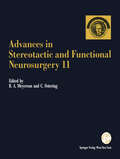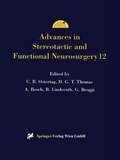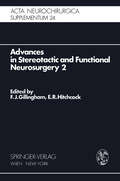- Table View
- List View
Advances in Safety Management and Human Factors: Proceedings of the AHFE 2018 International Conference on Safety Management and Human Factors, July 21-25, 2018, Loews Sapphire Falls Resort at Universal Studios, Orlando, Florida, USA (Advances in Intelligent Systems and Computing #791)
by Pedro Miguel ArezesThis book discusses the latest findings on ensuring employees’ safety, health, and welfare at work. It combines a range of disciplines – e.g. work physiology, health informatics, safety engineering, workplace design, injury prevention, and occupational psychology – and presents new strategies for safety management, including accident prevention methods such as performance testing and participatory ergonomics. The book, which is based on the AHFE 2018 International Conference on Safety Management and Human Factors, held on July 21–25, 2018, in Orlando, Florida, USA, provides readers, including decision makers, professional ergonomists and program managers in government and public authorities, with a timely snapshot of the state of the art in the field of safety, health, and welfare management. It also addresses agencies such as the Occupational Safety and Health Administration (OSHA) and the National Institute for Occupational Safety and Health (NIOSH), as well as other professionals dealing with occupational safety and health.
Advances in Safety Management and Human Performance: Proceedings of the AHFE 2020 Virtual Conferences on Safety Management and Human Factors, and Human Error, Reliability, Resilience, and Performance, July 16-20, 2020, USA (Advances in Intelligent Systems and Computing #1204)
by Pedro M. Arezes Ronald L. BoringThis book brings together studies broadly addressing human error and safety management from the perspectives of various disciplines, and shares the latest findings on ensuring employees’ safety, health, and welfare at work. It combines a diverse range of disciplines – e.g. work physiology, health informatics, safety engineering, workplace design, injury prevention, and occupational psychology – and presents new strategies for safety management, including accident prevention methods such as performance testing and participatory ergonomics. It reports on cutting-edge methods and findings concerning safety-critical systems, defense, and security, and discusses advanced topics regarding human performance, human variability, and reliability analysis; medical, driver and pilot error, as well as automation error; and cognitive modeling of human error. Further, it highlights cutting-edge applications in safety management, defense, security, transportation, process controls, and medicine. Gathering the proceedings of the AHFE 2020 International Conference on Safety Management and Human Factors and the AHFE 2020 Virtual Conference on Human Error, Reliability, Resilience, and Performance, held on July 16–20, 2020, USA, the book offers an extensive, timely, and multidisciplinary guide for researchers and practitioners dealing with safety management and human error.
Advances in Safety Management and Human Performance: Proceedings of the AHFE 2021 Virtual Conferences on Safety Management and Human Factors, and Human Error, Reliability, Resilience, and Performance, July 25-29, 2021, USA (Lecture Notes in Networks and Systems #262)
by Pedro M. Arezes Ronald L. BoringThis book provides readers with a timely snapshot of research and developments relating to human reliability, performance and safety analysis, and human error, risk and safety management in various industrial contexts, such as manufacturing, transportation and health. It combines a diverse range of disciplines, including work physiology, health informatics, safety engineering, workplace design, injury prevention, and occupational psychology, and presents new strategies for safety management, accident prevention at the workplace, performance testing and participatory ergonomics. It discusses issues related to automation, and strategies for a safer Human-Automation Interaction. Based on the proceedings of the AHFE 2021 International Conferences on Safety Management and Human Factors, and Human Error, Reliability, Resilience, and Performance, which were held virtually on July 25-29, 2021, from USA, the book offers an extensive and inspiring guide for both researchers and practitioners dealing with the topics of safety management, human error prevention, and integration of automation in the workplace.
Advances in Salivary Diagnostics
by Charles F. StreckfusThis book reviews the progress made in salivary diagnostics during the past two decades and identifies the likely direction of future endeavors. After an introductory section describing the histological and anatomical features of the salivary glands and salivary function, salivary collection devices and diagnostic platforms are reviewed. The field of “salivaomics” is then considered in detail, covering, for example, proteomics, the peptidome, DNA and RNA analysis, biomarkers, and methods for biomarker discovery. Salivary diagnostics for oral and systemic diseases are thoroughly discussed, and the role of salivary gland tissue engineering for future diagnostics is explored. The book closes by considering legal issues and barriers to salivary diagnostic development. Advances in Salivary Diagnostics will be an informative and stimulating reference for both practitioners and students.
Advances in Schizophrenia Research 2009
by Wagner F. Gattaz Geraldo BusattoSchizophrenia remains an important challenge to psychiatry, with its causes and underlying brain mechanisms yet to be fully revealed. Currently available treatments are neither universally effective nor without unwanted effects. These aspects, together with the high prevalence of schizophrenia, its often debilitating nature, and the associated family and social burden, make this mental disorder one of the most complex public health issues of our times. The purpose of the Advances in Schizophrenia Research series is to provide comprehensive periodic reviews of the wide range of research studies carried out around the world, with the dual purpose of solving the schizophrenia puzzle, and providing clues to new forms of treatment and prevention for this disorder. A special feature of the series is its broad scope, virtually encompassing all fields of schizophrenia research: epidemiology and risk factors; psychopathology; diagnostic boundaries; cognition; outcome and prognosis; pathophysiology; genetics; pharmacological and psychological forms of treatment and rehabilitation; community care; and stigmatization.
Advances in Service and Industrial Robotics: Proceedings of the 27th International Conference on Robotics in Alpe-Adria Danube Region (RAAD 2018) (Mechanisms and Machine Science #67)
by Nikos A. Aspragathos Panagiotis N. Koustoumpardis Vassilis C. MoulianitisThis volume contains the proceedings of the RAAD 2018 conference, covering major areas of research and development in robotics. It provides an overview on the advances in robotics, more specifically in novel design and applications of robotic systems; dexterous grasping, handling and intelligent manipulation; intelligent cooperating and service robots; advanced robot control; human-robot interfaces; robot vision systems and visual serving techniques; mobile robots; humanoid and walking robots; field and agricultural robotics; bio-inspired and swarm robotic systems; developments towards micro and nano-scale robots; aerial, underwater and spatial robots; robot integration in holonic manufacturing; personal robots for ambient assisted living; medical robots and bionic prostheses; intelligent information technologies for cognitive robots etc. The primary audience of the work are researchers as well as engineers in robotics and mechatronics.
Advances in Service and Industrial Robotics: Results of RAAD (Mechanisms and Machine Science #84)
by Saïd Zeghloul Med Amine Laribi Juan Sebastian Sandoval ArevaloThis book gathers contributions by researchers from several countries on all major areas of robotic research, development and innovation, as well as new applications and current trends. The topics covered include: novel designs and applications of robotic systems, intelligent cooperating and service robots, advanced robot control, human-robot interfaces, robot vision systems, mobile robots, humanoid and walking robots, bio-inspired and swarm robotic systems, aerial, underwater and spatial robots, robots for ambient assisted living, medical robots and bionic prostheses, cognitive robots, cloud robotics, ethical and social issues in robotics, etc. Given its scope, the book offers a source of information and inspiration for researchers seeking to improve their work and gather new ideas for future developments. The contents reflect the outcomes of the activities of RAAD (International Conference on Robotics in Alpe-Adria-Danube Region) in 2020.
Advances in Shoulder Surgery
by Kazuya Tamai Eiji Itoi Kenji TakagishiWith critical insights into anatomy and the latest science and research underlying pathogenesis, this book serves as a practical and richly illustrated step-by-step comprehensive guide to successfully performing shoulder surgery, and other related procedures. Abundant diagnostic and treatment approaches including arthroscopy are provided, and are intended to assist beginning and experienced orthopedic surgeons to further develop their skills and facilitate the management of patients with both acute and chronic shoulder injuries. The book provides full-color photos and diagrams to clearly demonstrate operative techniques and tools for surgery. Edited and written by pioneering researcher and surgeons, Advances in Shoulder Surgery offers a valuable guide to recent advances in shoulder surgery and treatment.
Advances in Simulation and Digital Human Modeling: Proceedings of the AHFE 2020 Virtual Conferences on Human Factors and Simulation, and Digital Human Modeling and Applied Optimization, July 16-20, 2020, USA (Advances in Intelligent Systems and Computing #1206)
by Daniel N Cassenti Sofia Scataglini Sudhakar L. Rajulu Julia L. WrightThis book presents the latest advances in modeling and simulation for human factors research. It reports on cutting-edge simulators such as virtual and augmented reality, multisensory environments, and modeling and simulation methods used in various applications, including surgery, military operations, occupational safety, sports training, education, transportation and robotics. Based on two AHFE 2020 Virtual Conferences such as the AHFE 2020 Virtual Conference on Human Factors and Simulation and the AHFE 2020 Virtual Conference on Digital Human Modeling and Applied Optimization, held on July 16–20, 2020, the book serves as a timely reference guide for researchers and practitioners developing new modeling and simulation tools for analyzing or improving human performance. It also offers a unique resource for modelers seeking insights into human factors research and more feasible and reliable computational tools to foster advances in this exciting field.
Advances in Simulation and Digital Human Modeling: Proceedings of the AHFE 2021 Virtual Conferences on Human Factors and Simulation, and Digital Human Modeling and Applied Optimization, July 25-29, 2021, USA (Lecture Notes in Networks and Systems #264)
by Julia L. Wright Daniel Barber Sofia Scataglini Sudhakar L. RajuluThis book provides readers with a timely snapshot of modeling and simulation tools, including virtual and mixed-reality environment, for human factors research. It covers applications in healthcare and physical ergonomics, military and transportation systems, industrial monitoring, as well as economics and social sciences. Based on the AHFE 2021 International Conference on Human Factors and Simulation and the AHFE 2021 International Conference on Digital Human Modeling and Applied Optimization, held virtually on 25–29 July, 2021, from USA, the book offers a unique resource for modelling and simulation researchers seeking insights into human factors research and to human factors experts seeking reliable computational tools.
Advances in Small Animal Total Joint Replacement (AVS Advances in Veterinary Surgery #6)
by Jeffrey N. Peck Denis J. Marcellin-LittleAdvances in Small Animal Total Joint Replacement provides an up-to-date, comprehensive examination of joint replacement in veterinary surgery. Part of the Advances in Veterinary Surgery series copublished with the ACVS Foundation, the book presents an evidence-based, multi-system examination of the current state of hip, knee, and elbow replacement in dogs and cats, including information on biomechanics and biomaterials not found in other sources. Written by an international group of experts, the book offers guidance on the history, indications, contraindications, clinical procedures, and a review of the current literature for these surgical techniques. Focusing on replacement of the hip, knee, and elbow, the book also covers disc, shoulder, carpus, and tarsus replacement, as well as information on the development of custom prostheses. Each section incorporates information on potential complications and outcomes assessment. Advances in Small Animal Total Joint Replacement is an unparalleled repository of information for veterinary surgeons, residents, and practitioners with an interest in these procedures.
Advances in Small Animal Total Joint Replacement (AVS Advances in Veterinary Surgery #5)
by Jeffrey N. Peck Denis J. Marcellin-LittleAdvances in Small Animal Total Joint Replacement provides an up-to-date, comprehensive examination of joint replacement in veterinary surgery. Part of the Advances in Veterinary Surgery series copublished with the ACVS Foundation, the book presents an evidence-based, multi-system examination of the current state of hip, knee, and elbow replacement in dogs and cats, including information on biomechanics and biomaterials not found in other sources. Written by an international group of experts, the book offers guidance on the history, indications, contraindications, clinical procedures, and a review of the current literature for these surgical techniques. Focusing on replacement of the hip, knee, and elbow, the book also covers disc, shoulder, carpus, and tarsus replacement, as well as information on the development of custom prostheses. Each section incorporates information on potential complications and outcomes assessment. Advances in Small Animal Total Joint Replacement is an unparalleled repository of information for veterinary surgeons, residents, and practitioners with an interest in these procedures.
Advances in Smart Healthcare Paradigms and Applications: Outstanding Women in Healthcare—Volume 1 (Intelligent Systems Reference Library #244)
by Halina Kwaśnicka Nikhil Jain Urszula Markowska-Kaczmar Chee Peng Lim Lakhmi C. JainThis book is dedicated to showcase research and innovation in smart healthcare systems and technologies led by women scientists, researchers, and practitioners. With the advent of artificial intelligence (AI) and related technologies, the healthcare sector has undergone tremendous changes in practice and management in recent years. On par to men, women have made significant contributions to tackle a variety of healthcare problems, creating smarter paradigms to provide effective and efficient solutions for patients and stakeholders. The book presents a small collection of contributions by outstanding women in STEM (Science, Technology, Engineering and Mathematics) education, focusing on the healthcare domain. The selected articles allow readers to comprehend current advances in AI and other methods for undertaking healthcare challenges. It is envisaged that the inspiring work by prominent women scientists, researchers, and practitioners reported in this book offers a beacon to propel women in pursuing STEM education and advancing the healthcare sector for the benefits of humankind.
Advances in Social Science Research Using R (Lecture Notes in Statistics #196)
by Hrishikesh D. VinodQuantitative social science research has been expanding due to the ava- ability of computers and data over the past few decades. Yet the textbooks and supplements for researchers do not adequately highlight the revolution created by the R software [2] and graphics system. R is fast becoming the l- gua franca of quantitative research with some 2000 free specialized packages, where the latest versions can be downloaded in seconds. Many packages such as “car” [1] developed by social scientists are popular among all scientists. An early 2009 article [3] in the New York Times notes that statisticians, engineers and scientists without computer programming skills ?nd R “easy to use.” A common language R can readily promote deeper mutual respect and understanding of unique problems facing quantitative work in various social sciences. Often the solutions developed in one ?eld can be extended and used in many ?elds. This book promotes just such exchange of ideas across many social sciences. Since Springer has played a leadership role in promoting R, we are fortunate to have Springer publish this book. A Conference on Quantitative Social Science Research Using R was held in New York City at the Lincoln Center campus of Fordham University, June 18–19, 2009. This book contains selected papers presented at the conference, representing the “Proceedings” of the conference.
Advances in Soft Computing and Its Applications: 12th Mexican International Conference, MICAI 2013, Mexico City, Mexico, November 24-30, 2013, Proceedings, Part II (Lecture Notes in Computer Science #8266)
by Félix Castro Alexander Gelbukh Miguel GonzálezThe two-volume set LNAI 8265 and LNAI 8266 constitutes the proceedings of the 12th Mexican International Conference on Artificial Intelligence, MICAI 2013, held in Mexico City, Mexico, in November 2013. The total of 85 papers presented in these proceedings were carefully reviewed and selected from 284 submissions. The first volume deals with advances in artificial intelligence and its applications and is structured in the following five sections: logic and reasoning; knowledge-based systems and multi-agent systems; natural language processing; machine translation and bioinformatics and medical applications. The second volume deals with advances in soft computing and its applications and is structured in the following eight sections: evolutionary and nature-inspired metaheuristic algorithms; neural networks and hybrid intelligent systems; fuzzy systems; machine learning and pattern recognition; data mining; computer vision and image processing; robotics, planning and scheduling and emotion detection, sentiment analysis and opinion mining.
Advances in Specialist Hip Surgery
by Wolf R. Drescher Kyung-Hoi Koo Russell E. WindsorThis book describes current and emerging techniques in hip surgery, providing the essential, up-to-date knowledge that will be required by the orthopaedic surgeon who plans to become a specialist hip surgeon. The opening chapter offers a concise overview of the surgical anatomy, with particular attention to details relevant to the surgical techniques outlined in the book. The increasingly popular anterior minimally invasive approach to the hip and a microinvasive variation of this approach are then described. Subsequent chapters present surgical approaches to developmental disorders of the hip, including dysplasia and femoroacetabular impingement, and promising hip preservation techniques for avascular necrosis of the hip – an often neglected but internationally relevant disease that can mutilate the hip in young patients. Finally, the latest techniques and implants for primary and revision hip arthroplasty are discussed in depth. The international author team consists of recognized leaders in the field, many of whom have developed the described classifications and new surgical techniques.
Advances in Sports Cardiology
by A. Pelliccia G. Caselli P. BellottiThe original articles included in the present book have primarily been taken from papers presented at the International Advanced Course, more precise the Master on Sports Cardiology, held in Rome from November 27 to December 15 1995 at the School of Sport and Institute of Sport Sciences of the Italian National Olympic Committee. The contributions, written by internationally acknowledged scientists, appeared after extensive and careful revision by the Authors, and represent current and highly profitable scientific material. The incentive to publish this work came from Springer-Verlag, a renowned publi sher, and the articles have been compiled in Advances in Sports Cardiology. The present volume is an easy-to-consult, comprehensive and up-to-date refe rence. Possible future developments in cardiovascular evaluation in athletes have been covered, too. The cardiological evaluation of athletes represents a more than 30 years-old discipline in"Italy, with legal implications, which compel physicians in this field to investigate in each individual athlete the possible, innermost causes of cardiovascular abnormality and to express a circumstantial prognostic asses sment. Cardiologists in this field should have an extensive background in phy siology but should also be aware of the indications and limits of the instrumen tal diagnostic procedures used in clinical practice as well as of the distinction between normal physiological adaptation to exercise and training and a true pathological cardiac process. Hence, sound basis in physiology with a major interest in clinical practice distinguishes sports cardiology as a new and origi nal discipline.
Advances in Statistical Methods for Genetic Improvement of Livestock (Advanced Series in Agricultural Sciences #18)
by Daniel Gianola Keith HammondDevelopments in statistics and computing as well as their application to genetic improvement of livestock gained momentum over the last 20 years. This text reviews and consolidates the statistical foundations of animal breeding. This text will prove useful as a reference source to animal breeders, quantitative geneticists and statisticians working in these areas. It will also serve as a text in graduate courses in animal breeding methodology with prerequisite courses in linear models, statistical inference and quantitative genetics.
Advances in Statistical Methods for the Health Sciences: Applications to Cancer and AIDS Studies, Genome Sequence Analysis, and Survival Analysis (Statistics for Industry and Technology)
by Jean-Louis Auget N. Balakrishnan Mounir Mesbah Geert MolenberghsStatistical methods have become an increasingly important and integral part of research in the health sciences. Many sophisticated methodologies have been developed for specific applications and problems. This self-contained comprehensive volume covers a wide range of topics pertaining to new statistical methods in the health sciences, including epidemiology, pharmacovigilance, quality of life, survival analysis, and genomics. The book will serve the health science community as well as practitioners, researchers, and graduate students in applied probability, statistics, and biostatistics.
Advances in Statistics - Theory and Applications: Honoring the Contributions of Barry C. Arnold in Statistical Science (Emerging Topics in Statistics and Biostatistics)
by Indranil Ghosh N. Balakrishnan Hon Keung Tony NgThis edited collection brings together internationally recognized experts in a range of areas of statistical science to honor the contributions of the distinguished statistician, Barry C. Arnold. A pioneering scholar and professor of statistics at the University of California, Riverside, Dr. Arnold has made exceptional advancements in different areas of probability, statistics, and biostatistics, especially in the areas of distribution theory, order statistics, and statistical inference. As a tribute to his work, this book presents novel developments in the field, as well as practical applications and potential future directions in research and industry. It will be of interest to graduate students and researchers in probability, statistics, and biostatistics, as well as practitioners and technicians in the social sciences, economics, engineering, and medical sciences.
Advances in Stereotactic and Functional Neurosurgery: Proceedings of the 1st Meeting of the European Society for Stereotactic and Functional Neurosurgery, Edinburgh 1972 (Acta Neurochirurgica Supplement #21)
by F. John Gillingham E. R. Hitchcock J. W. TurnerAdvances in Stereotactic and Functional Neurosurgery 10: Proceedings of the 10th Meeting of the European Society for Stereotactic and Functional Neurosurgery Stockholm 1992 (Acta Neurochirurgica Supplement #58)
by Assoc. Professor Dr. Björn A. Meyerson Professor Dr. Giovanni Broggi Professor Dr. Jose Martin-Rodriguez Professor Dr. Christoph Ostertag Professor Dr. Marc SindouThese proceedings from the Xth Congress of the European Society for Stereotactic and Functional Neurosurgery in Stockholm reflect the growing interest in these fields of neurosurgery. It is the most extensive volume in this series of publications and it contains a large number of original articles pertaining to the most recent advances in stereotactic and functional neurosurgery. Not long ago stereotactic neurosurgery was considered an esoteric sub speciality practised only by those involved in treating movement disorders and pain. In the last decade we have witnessed the incorporation of stereotactic methodology in the management of common neurosurgical diseases, and the stereotactic technique is now practised in all major neurosurgical centers. As with other surgical techniques and tools, however, the utilization of stereotactic methods requires special knowledge and training. This book comprises articles which give insight into new stereotactic applications and technology. For example, the usage of stereotaxis without a frame and the so-called navigator systems in open tumor surgery is dealt with in two papers. The introduction and development of radiosurgery is closely linked to the advancement of stereotactic technique. Radiosurgical treatment of tumors and cerebrovascular diseases has been one of major achievements in modern neurosurgery. This publication contains several original reports illustrating the efficacy of radiosurgery in problematic neurosurgical diseases.
Advances in Stereotactic and Functional Neurosurgery 11: Proceedings of the 11th Meeting of the European Society for Stereotactic and Functional Neurosurgery, Antalya 1994 (Acta Neurochirurgica Supplement #64)
by Björn A. Meyerson and Christoph OstertagThis volume contains selected contributions from the XIth Meeting of the European Society for Stereotactic and Functional Neurosurgery held in September 1994 in Antalyaffurkey. Most of the papers deal with the many therapeutic and technical advancements made in this field of neurosurgery. The emergence of new stereotactic methodologies such as frameless stereotaxy and other forms of neuronavigation have become an indispensable tool for all types of neurosurgical operations. An increasing number of young neurosurgeons takes an interest in the neurosurgical approaches to the treatment of movement disorders, chronic pain and epilepsy. This is a clear sign ofthe growing awareness of the long neglected fact that these neurosurgical treatments can be offered to large patient populations. Neurotransplantation as a novel treatment of Parkinson's disease has paved the way for the application of this technology for other indications. The pioneering work performed by the late Edward Hitchcock is reviewed here. There is a renewed interest in pallidotomy for dealing with certain forms of Parkinson's disease and certain aspects of this operation are discussed in another paper. Progress in the neurosurgical treatment of pain is dealt with by contributions on refined techniques of percutaneous cordotomy, DREZ operations and critical evaluations of spinal cord stimulation. A novel approach is a report on the experiences of treating cancer pain by intraspinal implantation of chromaffin cells. Several contributions cover the important issues of novel techniques for the study of neural dysfunction, peroperative monitoring with PET, microrecording, magneto-encephalography and other techniques.
Advances in Stereotactic and Functional Neurosurgery 12: Proceedings of the 12th Meeting of the European Society for Stereotactic and Functional Neurosurgery, Milan 1996 (Acta Neurochirurgica Supplement #68)
by C. B. Ostertag, D. G. T. Thomas, A. Bosch, B. Linderoth and G. BroggiNeurosurgery o/the Future: Computers and Robots in Clinical Neurosurgical Practice and in Training - a Philosophical Journey into the Future Many present day neurosurgeons believe that they already obtain good results in operative surgery with the benefit of the operating microscope and other aids which have become available in the last three decades and that the introduction of computers and robots to the operating theatre is superfluous. However, it is clear from analogy with the function of the airline pilot, another profession where there are great demands on manual skill and on spatial awareness, that these devices do have much to offer neurosurgery. Classical neurosurgery, in the time of Cushing, Dandy and Scarff, was based on a three dimensional picture of the patient's brain formed in the surgeon's mind and often illustrated in elegant drawings. Such pictures were based on neuroradiological studies by pneumoencephalography, ventriculography or by angiography. Generally these stud ies showed the presence and position of a lesion by displacement of normal brain structures and the picture was built up by interference. This was then converted by the experienced neurosurgeon into a plan for the craniotomy site and the trajectory of the surgical approach. Once the brain was exposed further pre-operative information was obtained by visual inspection and by palpation with the brain needle. These classical forms ofneuroradiology have largely been superseded by computerised tomography and by magnetic resonance imaging.
